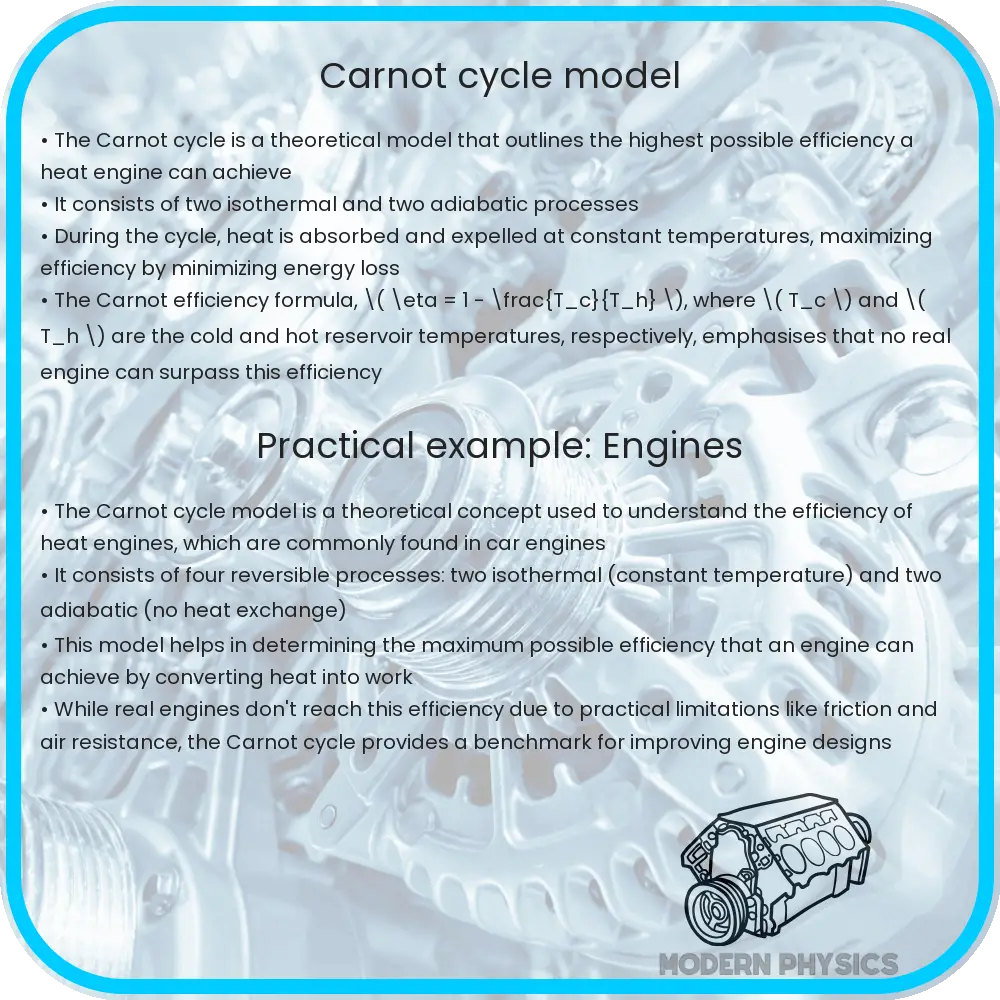Explore the Carnot Cycle: its efficiency, stages, real-world applications, and impact on sustainable energy in our comprehensive guide.

Understanding the Carnot Cycle: A Fundamental Concept in Thermodynamics
The Carnot Cycle is a cornerstone in the study of thermodynamics, serving as an idealized model for heat engines. This theoretical construct, proposed by French physicist Sadi Carnot in the 19th century, provides insights into the efficiency and workings of heat engines, which convert thermal energy into mechanical work.
Efficiency of the Carnot Cycle
At the heart of the Carnot Cycle is the concept of efficiency. The efficiency of any heat engine is defined as the ratio of the work done by the engine to the heat input at the high temperature. The Carnot efficiency, denoted as η, is expressed mathematically as:
η = 1 – (Tlow / Thigh)
Here, Tlow and Thigh are the absolute temperatures of the cold and hot reservoirs, respectively. Notably, this equation underscores that no engine operating between two heat reservoirs can be more efficient than a Carnot engine.
Stages of the Carnot Cycle
The Carnot Cycle consists of four reversible processes: two isothermal (constant temperature) and two adiabatic (no heat transfer).
- Isothermal Expansion: The working substance, often an ideal gas, expands isothermally, absorbing heat Qhigh from the high-temperature reservoir.
- Adiabatic Expansion: The gas continues to expand, but now adiabatically, causing its temperature to drop to Tlow.
- Isothermal Compression: The gas is compressed isothermally, releasing heat Qlow to the low-temperature reservoir.
- Adiabatic Compression: The cycle concludes with adiabatic compression, raising the gas’s temperature back to Thigh.
These stages are often depicted in a P-V (Pressure-Volume) diagram, showing the cyclic nature of the process.
Heat and Work Transfer in the Carnot Cycle
The Carnot Cycle also illustrates the relationship between heat and work transfer. During isothermal expansion, the system does work on the surroundings while absorbing an equivalent amount of heat. Conversely, during isothermal compression, the system absorbs work and releases heat. The adiabatic stages involve work transfer but no heat exchange. The net work done by the cycle equals the difference between the heat absorbed and released, highlighting the conversion of heat into work.
This theoretical model, while ideal and not fully attainable in real-world applications, sets the upper limit for the efficiency of heat engines and inspires ongoing innovations in energy systems.
Real-World Applications and Limitations
The principles of the Carnot Cycle find applications in various engineering fields, particularly in the design of thermal machines like steam turbines, refrigerators, and internal combustion engines. However, real-world systems often deviate from the ideal Carnot efficiency due to factors like friction, heat losses, and material limitations. These practical considerations lead to the development of more realistic models that take into account the irreversibilities and losses in actual engines.
Environmental Impact and Future Directions
Understanding the Carnot Cycle is also crucial in addressing environmental concerns. As the cycle sets the benchmark for the maximum possible efficiency, it guides engineers in designing more energy-efficient systems, thereby reducing fuel consumption and greenhouse gas emissions. The ongoing research in this field aims to bridge the gap between the theoretical efficiency of the Carnot Cycle and the actual efficiencies of real engines, focusing on innovative materials, alternative energy sources, and advanced engineering techniques.
The Role of the Carnot Cycle in Education and Research
In educational settings, the Carnot Cycle is a fundamental concept taught in physics and engineering courses. It provides a clear and concise framework for understanding the laws of thermodynamics and the principles governing heat engines. Furthermore, research in thermodynamics continues to be influenced by the concepts derived from the Carnot Cycle, pushing the boundaries of what is theoretically and practically achievable in thermal systems.
Conclusion
The Carnot Cycle remains a pivotal concept in thermodynamics, symbolizing the ideal performance of heat engines. While actual engines cannot achieve the Carnot efficiency, this model serves as a valuable benchmark and a source of inspiration for advancements in thermal engineering. It underscores the perpetual quest for higher efficiencies and environmentally sustainable energy solutions. In the face of growing energy demands and environmental challenges, the principles of the Carnot Cycle will continue to play a vital role in shaping the future of energy systems worldwide.
As we continue to innovate and push the boundaries of what is possible, the legacy of Sadi Carnot and his theoretical cycle will persist, guiding engineers and scientists in their pursuit of more efficient, sustainable, and environmentally friendly energy solutions.
